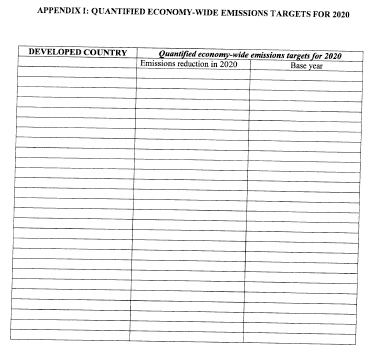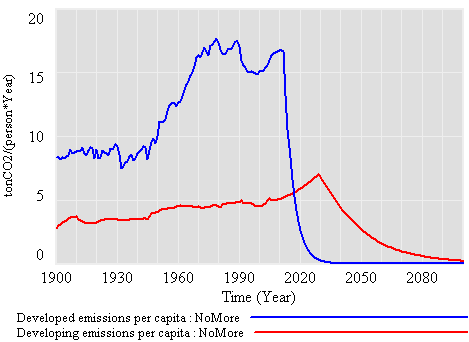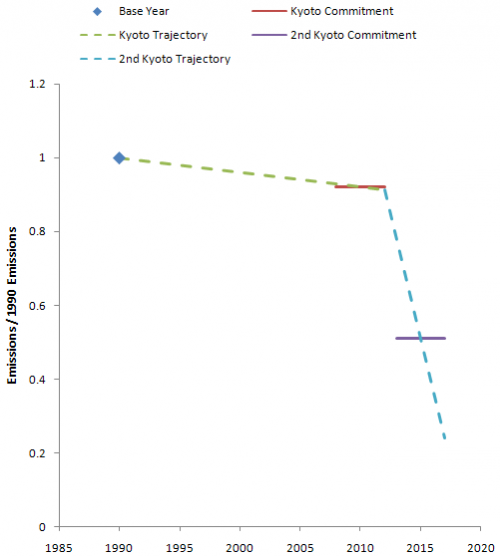Month: December 2009
COP15 Insights & Observations
A few random insights that I scribbled down during the process:
- Blame the system, not the people. A lot of people worked incredibly hard towards something positive. There were some screwups (late injection of the Danish text?), but on the whole, things didn’t come together because the structure wasn’t in place for them to do so.
- The US came to the table with nothing to offer – a tentative commitment, but no money and no headroom for bigger commitments.
- There’s little trust between parties. The developed world needs to demonstrate something concrete (significant emissions cuts or big $) before the developing world will budge.
- You can’t fix historic emissions inequity with future emissions – unless you don’t care about anything remotely like a 2C target.
- It’s not just about climate – development, resource management, and many other problems are intertwined.
- When major unstated values or mental models are in conflict, the COP process reverts to niggling over unimportant administrative details.
- It’s a good idea not to register more participants than you can handle.
- Analysis and decision support are probably not the key constraint at this time (maybe later). Negotiators need more scope from their home constituencies to be able to reach agreement.
- Emissions and welfare are not the same thing.
- Deep cuts for the world imply ~100% cuts (or more) in the developed world.
- It’s tough to reach 100% cuts due to fixed process emissions and activities for which it is difficult to substitute for hydrocarbon fuels.
- A number of industries are planning on more than their share of the remaining x% of emissions – how will it really add up?
COP15 Sound Bites
I’ve been looking over the final COP15 decision (here, for now). So far it all looks nonbinding. I was curious how some of the players are reacting.
“Today’s agreement leaves the U.S. in control of its own destiny. … As President Obama said today, strong action on climate change is in America’s national interest.” — EDF’s Fred Krupp, Dec. 18, 2009
“The world’s nations have come together and concluded a historic–if incomplete–agreement to begin tackling global warming. Tonight’s announcement is but a first step and much work remains to be done in the days and months ahead in order to seal a final international climate deal that is fair, binding, and ambitious. It is imperative that negotiations resume as soon as possible.
…
“The agreement reached here has all the ingredients necessary to construct a final treaty–a mitigation target of 2 degrees Celsius, nationally appropriate action plans, a mechanism for international climate finance, and transparency with regard to national commitments. President Obama has made much progress in past 11 months and it now appears that the U.S.–and the world–is ready to do the hard work necessary to finish what was started here in Copenhagen.
Copenhagen a cop-out
Two years have passed since world leaders promised all of us a deal to stop climate change. After two weeks of UN negotiations, politicians breezed in, had dinner with the Queen, a three hour lunch, took some photos, and then delivered what could only be described as the 24-hour Head of State tourist brochure of Copenhagen instead of a climate treaty.
League of Conservation Voters (via email)
I’m in Copenhagen and President Obama has just wrapped up a press conference here announcing that a meaningful climate deal has been reached. While there is still much work to be done, the deal reached is a breakthrough for international climate cooperation and provides a path forward towards a binding global treaty in 2010.
Significantly, the United States and China will – for the first time – both be at the table, working to tackle the historic challenge of global climate change. Additionally, the deal allows for more transparency, as developed and developing countries have now agreed to list their national actions and commitments regarding greenhouse gas reductions.
“We agree with President Obama on the importance of addressing global climate change. However, Congress’s leading proposals could destroy millions of jobs, drive up fuel prices, and, by shifting much of our refining capacity abroad (along with refinery greenhouse gas emissions), substantially increase our reliance on foreign supplies of gasoline, diesel and other petroleum fuels. Worse, the president’s own EPA is poised to issue an expansive regimen of climate regulations that could cripple business growth and job creation, dimming employment hopes for 15 million now out-of-work Americans.
…
“Public support for government climate change proposals has waned. It’s time for all stakeholders to come together to craft a fair, efficient, market-based climate change strategy that minimizes the burden on consumers and jobs.”
Can’t find a final reaction yet: USCAP, WWF, ECF, and many others. Seems like the press releases haven’t all hit yet.
Update 12/22: a nice summary at Roger Peilke’s blog.
The Midnight Accord
I’ve updated my Google spreadsheet summary of Copenhagen draft texts, with the latest iteration from just before midnight on Friday the 18th at far right. I think this table of commitments sums up the enforceable portion of the accord:

In short, not much for us to analyze.
Confidential memo: off track
The headline today is that emissions pledges don’t match needs. A leaked UNFCC secretariat memo indicates that current commitments hit 3C.* A ClimateInteractive reference is scrawled in the margins. It’s interesting that this is regarded with surprise, as we said it in March, Rogelj et al. said it in Nature in June, and it was intuitively evident before that. Climatescoreboard, climateactiontracker, and others are now monitoring the possible outcome in near-real-time. Our dream, over beers in Copenhagen on Thanksgiving in 2008, was to provide fast feedback to inject some reality into negotiations. It’s working!
* Update: As Joe Romm points out, the Guardian and other coverage is just wrong. The secretariat analysis covers current commitments prior to COP15, not possible deals. The various drafts circulating (as you can see in analysis here this week) yield a wide range of outcomes, including 1.5C. There’s no way to nail down the final outcome until the contested bracketed text in the drafts is finalized.
Update 2: We at ClimateInteractive are doing lots of evaluation of draft language using C-ROADS and a simpler emissions model that I developed, but we’re not going to report on the outcome until there’s a definitive text. Some of the insights from that analysis are reported in posts here this week, but obviously it’s all hypothetical at this point.
Cumulative emissions, right and wrong
During C-ROADS development, we explored several ways of accounting for cumulative per capita emissions. One practice that seems to be widespread is to accumulate (integrate) emissions divided by population, i.e.
| cumulative emissions per cap | = INTEGRAL( emissions per capita(t) ) |
| = INTEGRAL( emissions(t)/population(t) ) |
This is physically meaningless. Emissions per capita is an intensive variable, and you can’t average or accumulate intensive variables in this way. It’s like averaging the temperature of a duck and a supertanker without accounting for the tankers 100,000x greater mass.
A proper thing to do is integrate emissions, then divide by population:
| cumulative emissions per cap | = INTEGRAL( emissions per capita(t) ) / population |
That yields a physically meaningful number, interpreted as cumulative emissions of a nation per current inhabitant. That’s a bit like per capita national debt.
What about the price of carbon?
The mysterious emissions trajectories implicit in the various draft COP15 agreements got me thinking about the economic implications of various paths. Suppose the following scenario, consistent with the Beijing draft (Copenhagen Accord) or recent KP draft actually happened:
- deep 2020 cuts for the developed world
- no binding commitments for the developing world
- supported NAMAs in developing countries don’t count as offsets against developed country commitments (i.e. developed commitments are met domestically)
- border carbon adjustments (tariffs on the greenhouse gases embodied in trade goods) are illegal
- ongoing globalization
In that case, price of carbon would be very high in the developed world, and very low in the developing world. That creates intense pressure for leakage. Emissions-intensive industries would simply relocate to developing countries. Total emissions wouldn’t necessarily go down, except to the extent that relocated capital was newer and cleaner, and might even go up due to greater transport distance and less stringent environmental regulation.
Another consequence is that investors in the developing world, including governments investing in infrastructure, would proceed to build GHG-intensive capital that would just have to be unbuilt in a decade or two. That’s not development; it’s unsustainable lock-in to a dead-end economic, technical, and lifestyle trajectory.
Probably the first thing to happen would be for workers (aka voters) in the developed world to freak out at the resulting job losses, causing the whole agreement to unravel. So, I think you can scratch this kind of arrangement off the list of possible or attractive agreements. If we want to achieve the underlying development goals that motivate people to ask for such things, we need to find a different path.
You can't fix emissions inequity with more emissions
A lot of the draft agreements floating around reference a principle of equity in cumulative emissions budgets. For example, the latest AWG-LCA draft,
A long-term aspirational and ambitious global goal for emission reductions, as part of the shared vision for long-term cooperative action, should be based on the best available scientific knowledge and supported by medium-term goals for emission reductions, taking into account historical responsibilities and an equitable share in the atmospheric space;
That’s a nice sentiment, but the goals expressed here are not compatible. If you take “aspirational and ambitious” to mean 55oppm – much less stringent then a 1.5 or 2C target – we’re already halfway or more through civilization’s cumulative emissions budget. Most of the historic emissions occurred in the 20th century. The rest will happen this century. The problem is, there are a lot more people around this century than last. Therefore, this century’s remaining emissions budget just isn’t big enough to make up for historic inequity in emissions, even if you allocate it all to the developing world.
For example, here’s a scenario in which the developed world stops emitting almost immediately – essentially abandoning its GHG-intensive capital stock – while the developing world pursues a trajectory consistent with a global 50% cut by 2050. Per capita emissions convergence and reversal happens right away:

Continue reading “You can't fix emissions inequity with more emissions”
Random COP15 roundup
NGOs are mad that registered participants are being excluded, so they stage a walkout. Isn’t that like going on hunger strike to protest a food shortage?
For the record, I’m among the excluded. I don’t feel so bad now that friends tell me that I’m in good company – a former Danish prime minister didn’t make it in today, and even Al Gore had to wait an hour.
A colleague asked the leader of a Very Big Country delegation what he could do for him. The answer, “just pray for us.”
Bill McKibben stopped by to chat. He pointed out the current low price tag on deforestation proposals – $25 billion per year. A Big Mac, Coke and fries for everyone in the developing world. Yay!
The AWG-KP draft
I’ve added the Dec. 16 Kyoto Protocol working group draft to my summary table.
There’s not much to report with respect to the global outcome. Most of the detail is focused on Annex I (developed) country commitments. There are so many options and brackets in the text that it’s hard to draw any concrete conclusions about the implied emissions trajectory.
There’s possibly an interesting disconnect around characterization of the second round of targets. Currently there are a number of options included in bracketed text. First, the endpoint could be either 2017 or 2020. Second, various options suggest a range of cuts between 15% and 49% below 1990. This range corresponds roughly with the range typically cited as providing a decent chance of hitting a 2C target (see AR4 WG3 Ch. 13 box 13.7, pg. 776, for example).
If you think back to the first Kyoto agreement, countries committed to small cuts relative to 1990 for a commitment period from 2008 to 2012. For the EU, with an 8% cut, that meant averaging 92% of 1990 emissions over the commitment period. If you imagine that emissions fall along a linear path from 1990, that means that emissions at the midpoint (2010) would be 92% of 1990, and emissions would be a little higher prior to that, and lower after. Because the slope from 1990 through 2012 is shallow, a viable trajectory would include a 7% cut in 2008 and 9% in 2012. No big deal.
However, for the next commitment period, the slope is a very big deal. The deepest cut in the AWG-KP draft is 49% for the developed world. I suspect that number is anchored on upper end of the AR4 2C range (25-40%), moved up a bit. 49% still sounds plausible. But there’s a problem: to achieve a 49% average over 2013-2020, starting from a 9% cut in 2012, you’d have to do one of two things: reduce emissions an additional 37% overnight, then keep them there (basically impossible), or reduce emissions by 13 percentage points per year, arriving at a cut of 76% in 2017. That’s a year-on-year reduction rate of 15 to 35% per year. That’s pretty tough going, given that, even if you never build another bit of carbon-emitting capital, natural turnover takes you down at 2 to 5% per year.

I’m all for strong targets, but abandoning capital at 10% per year is going to be a tough sell. It’s not clear to me that this is intentional. I think it’s quite possible that misperception of the dynamics of a target accumulated over an interval leads to false conflict, as desire to achieve a point goal (e.g., -40% in 2020) is confused with a much more stringent goal over a long interval.
